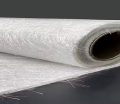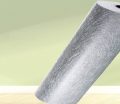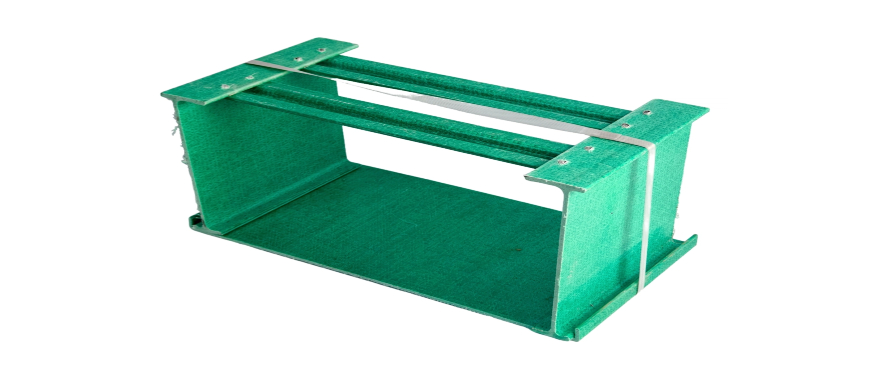
Durable epoxy coated cable tray with corrosion resistance, fire retardant & anti-aging properties for industrial electrical support. Cable trays are essential components in electrical systems, providing a reliable pathway for managing and organizing cables. They offer support for electrical wiring, ensuring safety and reducing the risk of damage or disorganization. Among the various types of cable trays, epoxy coated cable tray stands out due to its durable coating, which enhances its performance in specific environments. Epoxy-coated cable trays are designed to resist corrosion, chemicals, and wear, making them ideal for both indoor and outdoor applications where environmental factors may accelerate the deterioration of uncoated trays. This guide will explore the benefits of epoxy-coated cable trays, the different types available, and the best applications for these trays in both residential and industrial settings, helping you make an informed decision about which cable tray best suits your needs.
What Are Epoxy Coated Cable Trays?
An epoxy coated cable tray is a specialized cable management system that has been treated with a protective layer of epoxy resin. This epoxy coating serves as a robust shield, providing multiple benefits that enhance the tray’s performance in demanding environments. The primary function of the coating is to act as a protective barrier, safeguarding the epoxy cable tray against a variety of damaging factors such as corrosion, chemical exposure, fire, and physical wear. This makes epoxy coated cable trays a perfect solution for installations in locations with extreme conditions, where standard metal trays may not provide the same level of durability.
Key Advantages of Epoxy Coated Cable Trays
Epoxy coated cable trays are highly regarded for their ability to withstand harsh environmental conditions. The protective epoxy layer enhances the durability and functionality of the trays, making them suitable for demanding applications across various industries. Here are some key advantages, factors, and examples that highlight the benefits of using epoxy-coated cable trays:
Superior Corrosion Resistance
One of the primary advantages of epoxy-coated cable trays is their superior resistance to corrosion. The epoxy coating forms a robust barrier against environmental elements such as moisture, chemicals, and saltwater. This corrosion-resistant feature makes epoxy-coated trays perfect for use in industries that face harsh conditions, such as chemical processing plants, marine environments, and power generation facilities. The trays can withstand prolonged exposure to corrosive substances without compromising their structural integrity, ensuring they remain functional for many years.
Enhanced Durability
Epoxy-coated cable trays are designed to endure harsh environmental stressors, including extreme temperatures, high humidity, and exposure to aggressive chemicals. The coating protects the trays from the wear and tear caused by these factors, ensuring they outlast uncoated metal trays. This enhanced durability not only helps to extend the lifespan of the trays but also reduces the frequency of maintenance and replacement, leading to significant cost savings over time. These trays are capable of withstanding physical stresses, including mechanical impacts, without suffering damage or losing their protective properties.
Improved Aesthetic and Cleanliness
Epoxy-coated cable trays offer a smooth and uniform surface that provides an attractive finish, making them ideal for installations where appearance matters. The coating also makes the trays easier to clean and maintain, which is especially beneficial in industries that require stringent cleanliness standards, such as pharmaceutical, food manufacturing, and healthcare sectors. The smooth surface reduces the accumulation of dust, dirt, and other contaminants, helping maintain a clean and organized environment. This feature is particularly important in facilities where hygiene is critical to both the safety and effectiveness of operations.
Better Insulation Properties
Another significant benefit of epoxy-coated cable trays is their improved insulation properties. The coating provides an additional layer of electrical insulation, reducing the risk of short circuits caused by accidental contact with conductive surfaces. This makes epoxy-coated trays a safer option in environments with high electrical requirements, such as power stations and data centers. By preventing electrical faults, epoxy-coated trays enhance the overall safety of the installation and protect sensitive equipment from potential damage caused by electrical surges or failures.
Cost-Effective in the Long Run
While the initial cost of epoxy-coated cable trays may be higher than untreated metal trays, their long-term benefits make them a more cost-effective solution. The superior resistance to corrosion and environmental degradation significantly extends the lifespan of the trays, reducing the need for frequent replacements or costly repairs. Over time, the reduced maintenance requirements and longer lifespan make epoxy-coated trays a more economical choice, especially in industries where regular maintenance and replacements can lead to operational downtime and additional costs.
Wide Range of Applications
Epoxy-coated trays are used in a variety of industries, including chemical plants, oil and gas facilities, power stations, and wastewater treatment plants. These trays are especially well-suited for environments where exposure to aggressive substances such as chemicals, acids, and solvents is common. The ability to withstand harsh chemicals, high humidity, and extreme temperatures makes epoxy-coated trays a versatile option for a wide range of applications. They are often preferred over traditional trays in industries where regular exposure to corrosive elements would cause rapid deterioration in uncoated trays.
Potential Drawbacks
While epoxy-coated cable trays offer significant benefits, there are some considerations to keep in mind:
- Initial Cost: The cost of epoxy-coated cable trays is higher than uncoated trays due to the coating process and materials involved.
- Risk of Damage During Installation: If not handled properly during installation, the epoxy coating can be damaged, reducing its effectiveness. Care must be taken to avoid scratches or dents in the coating.
Epoxy-coated cable trays offer superior protection in challenging environments. Their corrosion resistance, durability, and long-term cost-effectiveness make them an excellent choice for industries with stringent environmental and safety requirements.
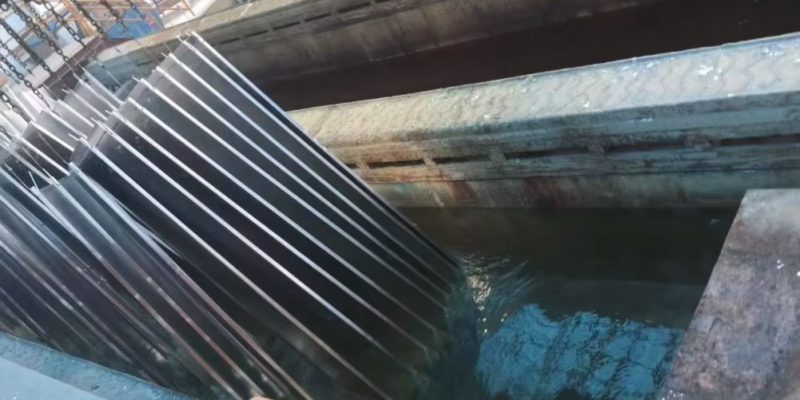
Understanding B Line Cable Tray Weight for Installations
Key Features of Epoxy Coated Cable Trays
Epoxy-coated cable trays offer several significant benefits that make them an ideal choice for demanding environments. Below are the key features of an epoxy coated cable tray:
Corrosion Resistance
Epoxy resin cable trays are highly resistant to corrosion, making them ideal for environments exposed to moisture, chemicals, and saltwater. The epoxy coating acts as a protective barrier, ensuring the trays retain their strength and durability even in corrosive settings like marine and chemical processing industries. This feature prolongs the lifespan of the trays, making them a reliable option for harsh environments.
Fire Retardant
Epoxy resin cable trays offer excellent flame-retardant properties, helping to prevent the spread of fire in industrial and hazardous environments. The epoxy coating reduces the risk of fire hazards, ensuring the safety of both cables and the surrounding area. This fire-resistant feature is especially crucial in high-risk environments, making these trays a safe and reliable choice for installations where fire protection is essential.
Durability and Long Life Expectancy
Epoxy resin cable trays are known for their durability, capable of withstanding heavy-duty use with minimal maintenance. They offer a long life expectancy, often exceeding 30 years, and resist wear and tear from environmental stresses. These trays maintain their structural integrity while efficiently supporting cables, making them an ideal choice for demanding installations that require reliable, long-lasting cable management solutions.
Environmental Resistance
Epoxy resin cable trays are designed to endure harsh environmental conditions, such as strong winds, rain, and ice. These trays are resistant to insect damage and will not fade or corrode over time, ensuring their long-term reliability. Their ability to perform in extreme weather and natural environments makes them a versatile solution for outdoor or industrial installations requiring robust cable management.
Electrical Insulation
Epoxy resin cable trays are electrically non-conductive, providing an added layer of safety in environments where electrical hazards must be minimized. This property helps prevent electrical accidents, making the trays suitable for sensitive applications like telecommunications and power distribution. Their electrical insulation adds to their reliability and safety, making them an essential choice for areas where electrical risks need to be controlled.
Low Maintenance and Customizable
Epoxy resin trays require minimal maintenance and can be easily cut to the desired length for specific installation needs. They offer flexibility for both vertical and horizontal installations, allowing for versatile cable management solutions. The trays’ low-maintenance nature and customization options make them an ideal choice for applications where ease of installation and long-term performance are essential.
Cable Tray Wall Penetration Sleeve: Essential for Safety
Types of Coatings: Ensuring Durability and Performance
Choosing the right coating for your cable trays is essential for ensuring durability and reliable performance in various environments. Epoxy coated cable trays, along with other coating types, offer specific advantages, from corrosion resistance to aesthetic appeal, and are tailored to meet the demands of different industrial applications. Each coating type, including epoxy, galvanized, powder, and PVC coatings, provides unique benefits and is suitable for various applications.
Steel Painted (GSE)
Steel painted with a hybrid epoxy-polyester resin offers superior corrosion protection. The process involves covering steel with powder resin and polymerizing at 185-190ºC for 15 minutes, resulting in a coating thickness of 60-80 microns. This method is applied to sendzimir galvanized steel or base steel, with pre-treatment that includes degreasing and phosphating to enhance the corrosion protection and ensure long-lasting performance in harsh environments.
Steel Painted with Polyester (GSP)
Steel coated with polyester resin undergoes polymerization at temperatures between 190-195ºC for 15 minutes, resulting in a coating thickness of 60-80 microns. This coating is applied to sendzimir galvanized steel or base steel. Before the application, the steel undergoes degreasing and amorphous phosphating treatment to improve the protection against corrosion. This process ensures excellent adherence and enhances the durability of the cable trays in industrial settings.
Duplex Steel (GCP)
Duplex steel consists of a hot-dip galvanized layer followed by a polyester resin coating. This two-layer system has a total thickness of approximately 160μm, enhancing corrosion resistance by combining the mechanical strength of galvanizing with the chemical resistance of the polyester resin. The system exceeds 850 hours in neutral salt spray tests, ensuring long-lasting protection and making it ideal for challenging environments where superior durability is required.
Epoxy Coating
Epoxy coatings are highly resistant to corrosion and chemicals, making them ideal for use in environments like chemical plants, oil refineries, and industrial facilities. These coatings provide robust protection against harsh substances, extending the lifespan of cable management systems. Epoxy-coated trays offer an excellent solution for applications requiring enhanced durability in demanding conditions, ensuring long-term reliability and performance under extreme circumstances.
Galvanized Coating
Galvanized coatings provide excellent corrosion resistance, making them a cost-effective option for outdoor installations. They are particularly useful in environments exposed to moisture and weather elements. Galvanized cable trays are ideal for use in locations where durability and resistance to corrosion are essential, ensuring that the trays maintain their structural integrity and longevity even in challenging outdoor conditions.
Powder Coating
Powder coating offers a smooth, durable finish available in various colors, combining aesthetic appeal with decent corrosion resistance. It is commonly used in commercial and office buildings, providing an attractive option for cable management systems that also require reliable performance. Powder-coated trays allow for seamless integration into office or workspace designs, offering both style and functionality without compromising durability.
PVC Coating
PVC-coated cable trays are perfect for environments exposed to extreme temperatures or corrosive substances. These coatings provide excellent resistance to chemicals and UV rays, making them highly suitable for industries such as petrochemicals and solar power. PVC coatings ensure that the trays remain durable and perform optimally under harsh conditions, offering long-lasting protection against environmental stressors.
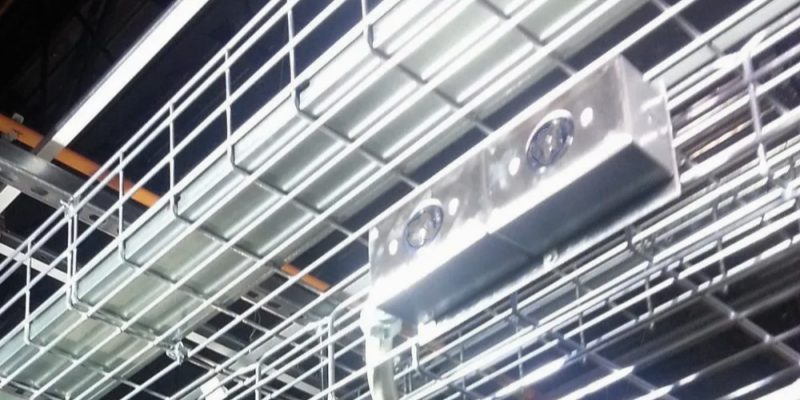
Types of Epoxy Coated Cable Trays
Epoxy-coated cable trays come in various types, each designed to meet specific cable management needs and environmental conditions. Here’s a detailed look at the most common types of epoxy coated cable tray:
Perforated Cable Tray
Epoxy coated cable trays with a perforated design are ideal for light to medium cable loads. These trays feature small holes or perforations throughout the tray, which allow for better ventilation and drainage of moisture, reducing the risk of rust and corrosion. The perforations also improve airflow, which helps to maintain the temperature of the cables. This type of tray is commonly used in communication and control cable installations, where moderate protection and ventilation are required.
Closed Cable Tray
For applications where maximum protection from external contaminants is necessary, a closed cable tray is the ideal choice. The closed design of this tray provides complete protection against dust, debris, and environmental contaminants. The epoxy coating further enhances the protection, making these trays suitable for sensitive cables, such as those in data centers, medical facilities, or clean rooms. This type of tray ensures that cables remain free from external interference and damage, extending their lifespan.
Ladder Type Tray
The ladder type epoxy coated cable tray offers a robust and open design that is perfect for managing heavy-duty cables. The open structure provides excellent cable support while allowing for airflow and heat dissipation, which is particularly important in high-heat environments. This type of tray is commonly used in industrial settings, such as power plants, factories, and manufacturing facilities, where heavy cables and large cable bundles are common.
Channel Cable Tray
For smaller cable runs in more compact spaces, the channel epoxy coated cable tray is a cost-effective and efficient solution. This tray type is more compact and economical compared to other types, making it ideal for installations in tight spaces, such as in smaller office buildings, residential complexes, or smaller industrial sites. It is easy to install and is typically used for light to medium cable runs, making it a versatile option for many different applications.
Stainless Steel Ladder Cable Tray
For environments that require extreme durability and protection, stainless steel ladder epoxy coated cable trays are an excellent choice. These trays are specially designed to withstand harsh conditions such as extreme temperatures, corrosive chemicals, and heavy-duty loads. The addition of an epoxy coating enhances the tray’s fire resistance, corrosion resistance, and overall longevity. These trays are widely used in high-risk environments like oil refineries, offshore platforms, and petrochemical industries, where maximum durability and protection are critical.
Selecting the right type of epoxy coated cable tray depends on the specific needs of your installation, including cable load, environmental factors, and durability requirements. Each type of tray provides unique benefits, ensuring that your cables are properly managed and protected in any setting.
Cable Tray Tee Fitting: Choosing the Right One for Your System
Epoxy Coated Cable Tray and Material Options and Epoxy Coating Compatibility
When selecting an epoxy coated cable tray, the underlying material of the tray plays a significant role in its durability, performance, and suitability for specific applications. The epoxy coating can enhance the properties of various base materials, ensuring that they are protected against corrosion, environmental damage, and other factors. Below is a closer look at some common materials used in cable tray construction and their compatibility with epoxy coatings:
Aluminum Cable Trays
- Lightweight and corrosion-resistant:
Aluminum cable trays are known for their light weight, making them easy to handle and install. They naturally resist corrosion, but applying an epoxy coated cable tray offers an additional layer of protection against moisture, chemicals, and saltwater. This makes aluminum trays ideal for coastal, marine, or other environments exposed to high levels of humidity. - Popular in coastal or marine applications:
Due to aluminum’s inherent resistance to corrosion, when combined with the epoxy coating, it becomes highly effective in harsh environments, particularly in coastal regions where exposure to saltwater and high humidity is common. The epoxy finish adds durability and ensures the trays maintain their structural integrity over time, even in challenging conditions. - Customizable epoxy coating for additional protection:
One of the key advantages of epoxy coated cable trays is the flexibility of the coating. It can be customized to provide varying levels of protection based on the specific needs of the environment. This can include enhanced chemical resistance or improved UV protection for aluminum trays used in outdoor or exposed settings.
Stainless Steel Cable Trays
- High strength and durability:
Stainless steel is known for its excellent strength and resistance to wear, making it a top choice for demanding environments. Stainless steel trays are capable of supporting heavy cables and are resistant to extreme temperatures and harsh chemicals. When combined with an epoxy coated cable tray system, they gain even further resistance to corrosion, making them highly durable and long-lasting. - Preferred in industrial or chemical-heavy environments:
Epoxy coated cable trays made from stainless steel are particularly suited for industrial applications, such as in chemical plants, manufacturing facilities, and power generation plants. The epoxy coating protects the stainless steel from chemical exposure and prevents rusting or degradation in environments where high levels of moisture or chemicals are present.
Galvanized Steel Cable Trays
- Cost-effective and strong:
Galvanized steel cable trays offer a strong, cost-effective solution for cable management. The galvanization process provides basic protection against corrosion, but when paired with epoxy coated cable trays, they gain an additional layer of protection. This combination results in a more robust tray that is resistant to both rust and external environmental factors. - Epoxy coating adds an extra layer of protection:
The application of epoxy coating to galvanized steel trays makes them suitable for a wider range of environments. The coating improves the tray’s resistance to corrosion, heat, moisture, and UV radiation, making them highly effective for both indoor and outdoor installations. This makes galvanized steel trays with epoxy coatings a great choice for cost-conscious projects without compromising on performance.
When choosing an epoxy coated cable tray, it’s important to consider the base material of the tray and its intended application. Aluminum, stainless steel, and galvanized steel each offer unique advantages, and combining them with the protective properties of epoxy coatings can greatly enhance the tray’s longevity and functionality. Whether you are working in a coastal, industrial, or general commercial environment, epoxy coated cable trays provide versatile and durable cable management solutions that help protect your cables and infrastructure for the long term.
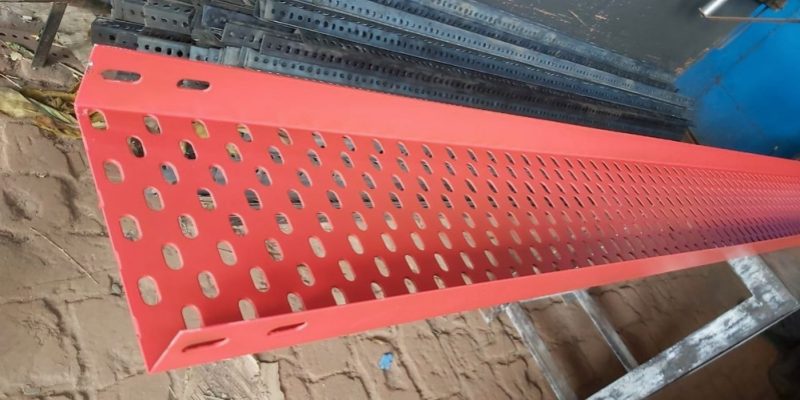
Applications of Epoxy Coated Cable Trays
Epoxy coated cable trays are highly versatile and offer superior protection in a wide range of environments. The durable epoxy coating adds a layer of resistance to environmental factors such as moisture, chemicals, and extreme temperatures. Below are some of the key applications of epoxy coated cable trays, showcasing how these trays are ideal for various industries and environments:
Industrial Plants
Epoxy coated cable trays are widely used in industrial facilities where the protection of cables is critical due to harsh operational conditions. Some common industrial applications include:
- Chemical processing plants: In environments where cables are exposed to corrosive chemicals and other hazardous substances, epoxy coated cable trays provide an additional layer of defense against deterioration. The coating prevents chemical and moisture damage to cables, ensuring long-term functionality and reducing maintenance costs.
- Oil refineries and power plants: These high-risk environments require reliable cable management systems. The epoxy coating helps protect cables from heat, UV exposure, and corrosive gases, making them highly suitable for industrial plants that need to adhere to stringent safety and operational standards.
- High-temperature environments: The durability of epoxy coated cable trays allows them to withstand the high temperatures often found in manufacturing and energy production facilities, ensuring that cables remain safe and functional even under extreme conditions.
Marine and Coastal Areas
In coastal or offshore environments, cable management solutions must be capable of enduring saltwater, moisture, and high humidity. Epoxy coated cable trays are particularly well-suited for these conditions due to their enhanced resistance to corrosion and environmental damage.
- Offshore platforms and oil rigs: Epoxy coated cable trays are widely used on offshore platforms where the risk of saltwater corrosion is high. The epoxy coating offers protection against the harsh elements, ensuring that cables remain safe and operational in such extreme settings.
- Docks and shipyards: The coastal exposure to saltwater makes these environments particularly challenging for cable management. The robust epoxy coating on these trays ensures they resist rusting and corrosion, which are common issues when cables are exposed to sea air and water.
- Shipping vessels: On ships, epoxy coated cable trays provide a reliable solution for managing cables while protecting them from the corrosive effects of sea spray and the harsh marine environment.
Commercial Buildings
In commercial buildings, epoxy coated cable trays serve a dual purpose: they not only provide a robust cable management system but also contribute to the aesthetic appeal of modern infrastructure.
- Modern office spaces: Many contemporary office designs emphasize clean, minimalist aesthetics, where exposed cables can be unsightly. Epoxy coated cable trays offer a sleek, uniform appearance while ensuring cables are properly secured and protected. The coating also resists dust and debris, maintaining a cleaner workspace.
- Retail and hospitality industries: In commercial spaces like hotels, malls, and retail stores, epoxy-coated cable trays can be integrated into the design to manage electrical and communication cables while blending seamlessly with the interior design. Their durability and protective coating ensure the trays remain in good condition, reducing maintenance requirements.
- Data centers and server rooms: In environments where a large volume of sensitive cables need to be organized, epoxy coated cable trays provide excellent protection against heat, moisture, and potential fire hazards, helping maintain the integrity of the cables that power critical infrastructure.
Hazardous Environments
In areas where safety and protection are paramount due to the presence of hazardous materials, epoxy coated cable trays are indispensable. These environments require cable trays that can handle extreme conditions while offering protection from fire, explosion, or chemical exposure.
- Petrochemical plants: Epoxy coated cable trays are ideal for managing cables in petrochemical plants where explosive gases and chemicals are present. The coating not only enhances fire resistance but also protects cables from the corrosive effects of chemicals and oils, helping to prevent failures and ensuring safe operations.
- Mining operations: In underground and surface mining operations, where dust, humidity, and extreme temperatures are prevalent, epoxy coated cable trays provide added protection against corrosion and wear. This extends the life of both the trays and the cables they house, reducing downtime and the need for frequent replacements.
- Explosive zones: In areas where flammable gases and chemicals exist, such as refineries or military installations, epoxy coated cable trays provide an extra layer of safety. The fire-retardant properties of the epoxy coating reduce the risk of fire spreading from damaged cables, offering a safer environment for workers and operations.
Epoxy coated cable trays offer versatile and highly effective solutions for cable management across a variety of industries. Their resistance to corrosion, fire, and environmental damage makes them ideal for demanding environments such as industrial plants, offshore platforms, commercial buildings, and hazardous areas. Whether it’s protecting cables from harsh chemicals, saltwater, or extreme temperatures, the epoxy coating ensures that these cable trays provide reliable and long-lasting protection for both the cables and the infrastructure they support.
FAQs about Epoxy Coated Cable Tray
Cable trays should be coated with materials that provide long-lasting protection against environmental damage, wear, and corrosion. Common coatings for cable trays include:
Epoxy Coating: Epoxy coatings are widely used because they offer excellent corrosion resistance, durability, and fire retardancy. They are particularly useful in harsh environments like chemical plants, offshore platforms, and industrial settings where exposure to moisture, chemicals, and extreme temperatures is common.
Powder Coating: This is a popular coating option because of its smooth finish and the protection it provides against rust, corrosion, and abrasions. Powder-coated trays are suitable for indoor applications and environments that aren’t exposed to excessive moisture.
Galvanizing: Galvanized steel trays are coated with a layer of zinc to protect them from corrosion. This is a highly effective and cost-efficient coating for outdoor applications or environments where trays are exposed to moisture or other corrosive elements.
Plastic Coating: For environments that require additional insulation or protection from chemicals, plastic-coated trays are used. This coating offers a layer of protection that shields cables from acids, bases, and solvents, making them ideal for industries dealing with chemicals or water exposure.
The choice of coating depends on the specific needs of the environment, such as exposure to corrosion, fire risk, or aesthetic considerations.
Cable trays come in several types, each designed for different cable management needs. The three main types of cable trays are:
Ladder Cable Tray: This is the most common type and is designed for heavy-duty cable management. It features a wide, open design that allows air circulation, making it ideal for managing high volumes of cables or cables that produce heat. The ladder design provides stability and strength, making it suitable for industrial settings or areas with large cable bundles.
Perforated Cable Tray: This type of tray has holes or perforations along its sides, which offer better ventilation and allow for easier cable management. It is typically used for medium-duty cable management in offices, data centers, or communication systems. The perforated design helps in organizing cables while maintaining a clean, clutter-free environment.
Solid Bottom Cable Tray: Solid bottom trays are designed to provide complete protection for the cables. They are best suited for applications where cables need to be protected from dust, dirt, or environmental contaminants. This type of tray is typically used for sensitive or delicate cables in areas such as laboratories, clean rooms, or areas that require fire resistance.
Each of these types has its advantages, and the choice of cable tray depends on the specific requirements of the installation, such as load-bearing capacity, ventilation needs, and environmental protection.
Yes, cable trays often need to be bonded to ensure electrical continuity and safety. Bonding refers to the process of connecting the cable tray to the building’s grounding system to prevent electrical hazards. There are several reasons why bonding is important:
Electrical Safety: Bonding ensures that the metal parts of the tray are grounded, preventing electrical shock or fire hazards in case of a fault or short circuit. It helps in diverting stray electrical currents safely to the ground.
Preventing Electrostatic Discharge (ESD): In environments where sensitive equipment or electronics are installed, proper bonding helps prevent electrostatic discharge, which can damage delicate circuits and components.
Compliance with Codes and Standards: Electrical codes such as the NEC (National Electrical Code) require grounding and bonding of metal cable trays in certain applications to ensure safety and minimize the risk of electrical fires or shocks.
While bonding is typically required for metallic cable trays, non-metallic trays (such as those made from fiberglass or plastic) do not require bonding as they do not conduct electricity.
Cable trays are made from a variety of materials, each chosen based on the environmental conditions and specific needs of the installation. Common materials used in cable trays include:
Steel: Steel is one of the most commonly used materials for cable trays. It is strong, durable, and capable of supporting heavy cable loads. Steel trays are used in industrial and commercial environments and can be treated with coatings like galvanizing or epoxy to improve corrosion resistance.
Aluminum: Aluminum is lightweight, corrosion-resistant, and non-magnetic, making it suitable for use in areas where weight is a concern or in environments exposed to moisture. Aluminum trays are commonly used in coastal or marine environments due to their resistance to saltwater corrosion.
Galvanized Steel: Galvanized steel is steel that has been coated with a layer of zinc to protect it from rust and corrosion. This material is ideal for outdoor installations or areas exposed to water and chemicals.
Stainless Steel: Stainless steel trays are used in environments where high strength, durability, and resistance to harsh chemicals or high temperatures are required. They are commonly used in chemical plants, food processing, and pharmaceutical industries.
Fiberglass: Fiberglass cable trays are non-corrosive and lightweight, making them an excellent choice for harsh or outdoor environments. They are often used in industries that require resistance to chemicals, water, or extreme temperatures.
Plastic: Plastic cable trays, such as PVC trays, are used in environments that require insulation and protection from certain chemicals. They are lightweight, cost-effective, and easy to install but are not suitable for heavy-duty applications.
The material chosen depends on the specific requirements of the installation, such as environmental exposure, load-bearing needs, and electrical safety considerations.

As the editor of GangLong Fiberglass, I have years of experience and in-depth research, focusing on cable tray products, fiberglass solutions, and grille systems. I incorporate years of industry insights and practical experience into every content, committed to promoting the progress of the industry. At GangLong Fiberglass, my commitment is reflected in every product, from innovative cable trays to durable fiberglass solutions and sturdy grille systems. As an authoritative voice in the industry, my goal is to provide valuable information to professionals and businesses and promote forward-looking solutions.

